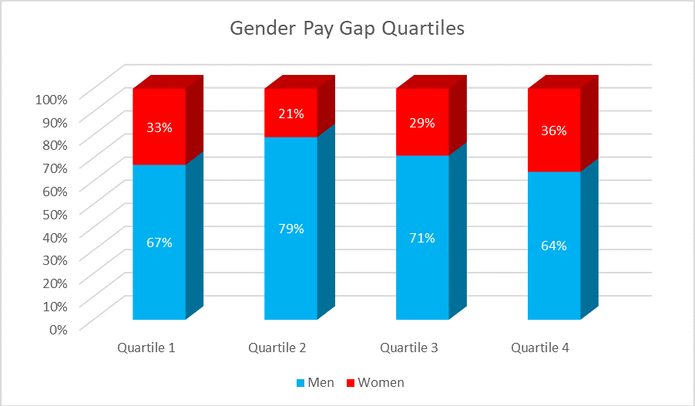Gender Pay Gap report
Table of Contents
Gender Pay Gap report
Introduction
Scottish Canals is reporting under the public sector equality duty to publish a gender pay gap report. This, our second gender pay gap report, is based on the snapshot date of 31st March 2018.
At the heart of the Scottish Canals Corporate Plan 2017-2020 is the core theme of empowering and motivating people. As part of our commitment to delivering against this plan we remain committed to ensuring that we create an environment where the diverse experiences, perspectives and backgrounds of our people are valued and utilised. We foster an inclusive and supportive culture where our interactions with each other, our customers and our stakeholders are founded on mutual respect.
What is the Gender Pay Gap?
The gender pay gap is the measure of the difference between the average earnings of men versus women and is expressed as a percentage of men’s pay. Reporting can be provided as a mean or median figure.
The Office of National Statistics reports that the median gender pay gap of the overall UK is currently 18.4%, this is the key measurement used by ONS in the UK to assess the difference in salary between males and females. The median is the figure that falls in the middle of a range when all employees’ salaries are lined up from smallest to largest. The median calculation is typically a more representative figure as it includes all staff. The mean figure, commonly known as the average and it is the difference between mean male pay and mean female pay.
Scottish Canals’ Gender Pay Gap
The mean pay-gap calculation is a measure of:
Male Average Salary – Female Average Salary = pay-gap (monetary)
Pay-gap (monetary) / male average salary x 100 = pay-gap%
- The mean gender pay gap for Scottish Canals is -6.54% (prior year -2.22%)
- The median gender pay gap for Scottish Canals is -6.37% (prior year 3.56%)
As detailed in the year on year data above there has been change in the % gap, the change has been a result of a lower number of female employees at the 2018 snapshot being paid at a higher hourly rate.
No bonus payments were made within the reporting period for male of female employees. Therefore:
- The mean gender bonus gap for Scottish Canals is 0% (prior year 0%)
- The median gender bonus gap for Scottish Canals is 0% (prior year 0%)
Mean gender pay gap

Median pay gap

Gender Pay Gap Quartiles

Scottish Canals’ gender pay gap is inconsistent with the pattern seen across the UK economy and work force and for public sector, the sector which we work the most closely with, which on average pays women 14% less than men. The gender pay gap is due to many factors including societal challenges such as too few women progressing to senior positions. Many women take time out of the labour market or work part time due to having children or are under-represented in certain industries and sectors. Like other employers, our gender pay gap and bonus gap are based on a data snap shot taken in March 2018 and reflect that the position was driven by:
- A higher proportion of women in more senior, higher paid roles;
- A higher proportion of men in more junior, lower paid roles;
- We recruit significant numbers of people from the engineering and estates profession which is male-dominated
Scottish Canals is confident that it’s negative gender pay gap does not stem from paying men and women differently for the same or equivalent work. Rather, the gap is the result of the roles in which men and women work within the organisation and the salaries that these roles attract. Scottish Canals is committed to addressing and improving this imbalance and ensuring there is no gender bias in the future.
Scottish Canals aims to ensure that it addresses inequality in employment outcomes, including a focus on the fair work convention, and promoting and fostering good working relationships with colleges and universities to mitigate the gender barriers, such as occupational segregation, which prevent sustained economic growth. By monitoring the pay gap between men and women, Scottish Canals can better understand it and therefore target action as appropriate. Examples of initiatives that are currently being undertaken include: becoming a happy to talk flexible working employer, delivery of training by the National Centre of Diversity and continually reviewing recruitment processes to ensure that the organisation adopts best-practice in terms of preventing unconscious-bias selection and recruitment.